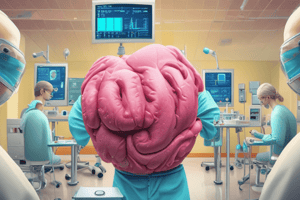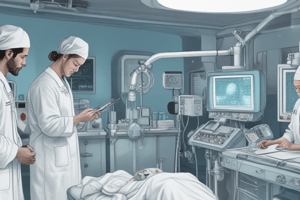Podcast
Questions and Answers
What is the purpose of using retractors during surgery?
What is the purpose of using retractors during surgery?
- To expose underlying structures (correct)
- To cut through tissues
- To move or manipulate body structures
- To minimize the risk of infection
Which surgical technique involves smaller incisions and less tissue disruption?
Which surgical technique involves smaller incisions and less tissue disruption?
- Endoscopy
- Minimally invasive surgery (correct)
- Robotic-assisted surgery
- Open surgery
What is one of the key aspects of postoperative care in the recovery process?
What is one of the key aspects of postoperative care in the recovery process?
- Preparing patients for surgery
- Encouraging patients to keep their incisions clean and dry (correct)
- Administering pain medication
- Using robotic devices
During which phase of the surgical experience are patients monitored for vital signs?
During which phase of the surgical experience are patients monitored for vital signs?
What is the main goal of preoperative care provided to patients?
What is the main goal of preoperative care provided to patients?
Which instrument is commonly used to hold tissues or organs during surgery?
Which instrument is commonly used to hold tissues or organs during surgery?
What is the main purpose of anesthesia in surgery?
What is the main purpose of anesthesia in surgery?
Which type of anesthesia numbs a specific part of the body?
Which type of anesthesia numbs a specific part of the body?
In surgery, what has evolved dramatically over the centuries?
In surgery, what has evolved dramatically over the centuries?
Which type of anesthesia involves injecting a local anesthetic into the skin?
Which type of anesthesia involves injecting a local anesthetic into the skin?
What do surgical instruments serve as in a surgeon's arsenal?
What do surgical instruments serve as in a surgeon's arsenal?
Which factor influences the choice of anesthetic method in surgery?
Which factor influences the choice of anesthetic method in surgery?
Study Notes
Surgery: A Deeper Dive into Anesthesia, Instruments, Techniques, Recovery, and Patient Care
Surgery, a delicate dance between skillful hands and scientific precision, has been transforming the field of medicine since ancient times. With advancements in anesthesia, surgical instruments, techniques, and postoperative care, surgery today offers hope and healing to millions of people. Let's explore the various aspects of this essential medical discipline.
Anesthesia: Providing Comfort and Pain Relief
Anesthesia is an indispensable part of surgery, allowing patients to undergo procedures with minimal or no pain. There are three main types of anesthesia:
- General anesthesia: Induces a state of unconsciousness, making patients unaware of the surgery and its associated pain.
- Regional anesthesia: Numbing a specific part of the body, such as a limb or the abdomen, thereby eliminating pain in the targeted area.
- Local anesthesia: Involves injecting a local anesthetic into the skin, numbing a small, specific area.
Anesthesiologists carefully choose the most appropriate anesthetic method based on the patient's health, age, and the type of surgery being performed.
Surgical Instruments: Enhancing Precision and Efficiency
As essential tools in a surgeon's arsenal, surgical instruments have evolved dramatically over the centuries. From crude knives and leeches to advanced laparoscopic and robotic devices, surgical instruments serve two main purposes:
- Dissection: Cutting through tissues to expose underlying structures.
- Manipulation: Moving or manipulating body structures for repair or reconstruction.
Examples of surgical instruments include scalpels, forceps, clamps, sutures, and retractors. Advancements in materials science have led to the development of biocompatible and sterilizable instruments that minimize the risk of infection.
Surgical Techniques: Mastering Procedures
Surgeons use a variety of techniques to perform procedures, depending on the specific operation. Some common techniques include:
- Open surgery: A traditional technique involving a single, large incision to access the surgical site.
- Minimally invasive surgery: Involving smaller incisions and less tissue disruption, resulting in shorter recovery times and reduced postoperative pain.
- Robotic-assisted surgery: Utilizing robotic devices that enable increased precision, flexibility, and control during complex procedures.
Other techniques include endoscopy, laparoscopy, and arthroscopy, which involve the use of long, thin instruments to access areas that are difficult to reach through traditional methods.
Recovery Process: Continuing Care and Healing
The recovery process following surgery is a crucial step in the patient's journey to healing. Postoperative care typically involves:
- Monitoring vital signs: Ensuring the patient's blood pressure, heart rate, and oxygen levels remain within an acceptable range.
- Managing pain: Administering pain medication and providing nonpharmacological methods for pain relief, such as relaxation techniques.
- Preventing infection: Encouraging patients to keep their incisions clean and dry, and administering antibiotics when necessary.
- Promoting mobility: Encouraging patients to move and engage in physical therapy to regain strength and flexibility.
Adequate rest and proper nutrition also play a significant role in the recovery process.
Patient Care: Providing Support and Empathy
Caring for patients before, during, and after surgery is an integral part of the surgical experience. Surgeons, anesthesiologists, nurses, and other medical professionals work together to ensure the patient's well-being and comfort.
- Preoperative care: Ensuring patients are prepared both physically and mentally for surgery, addressing any concerns and answering questions.
- Intraoperative care: Monitoring the patient's vitals and attending to any issues during the procedure.
- Postoperative care: Providing pain management, infection prevention, and physical therapy to aid in the patient's recovery.
In addition to medical care, surgeons and their teams also prioritize providing emotional support and empathy to patients and their families throughout the surgical experience.
The field of surgery is constantly evolving, with new technologies and techniques emerging to improve patient outcomes and reduce the risk of complications. As medical professionals continue to innovate and refine their approaches, surgery will continue to provide hope and healing for millions of people around the world.
Studying That Suits You
Use AI to generate personalized quizzes and flashcards to suit your learning preferences.
Description
Delve into the critical components of surgery, including anesthesia options, advancements in surgical instruments, various surgical techniques, the importance of postoperative recovery, and comprehensive patient care provided by medical professionals. Discover how these elements come together to enhance surgical outcomes and patient well-being.




